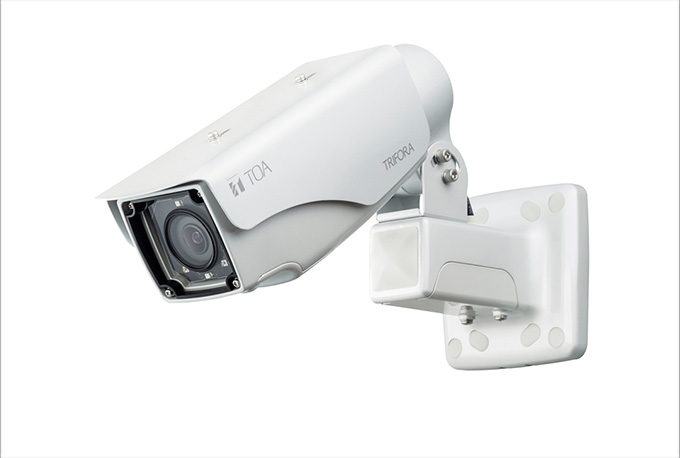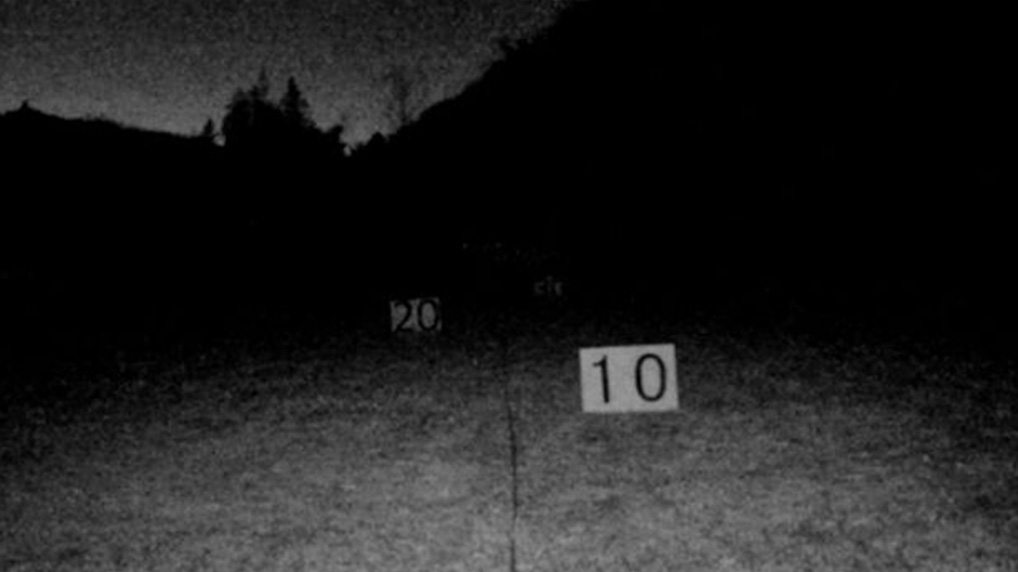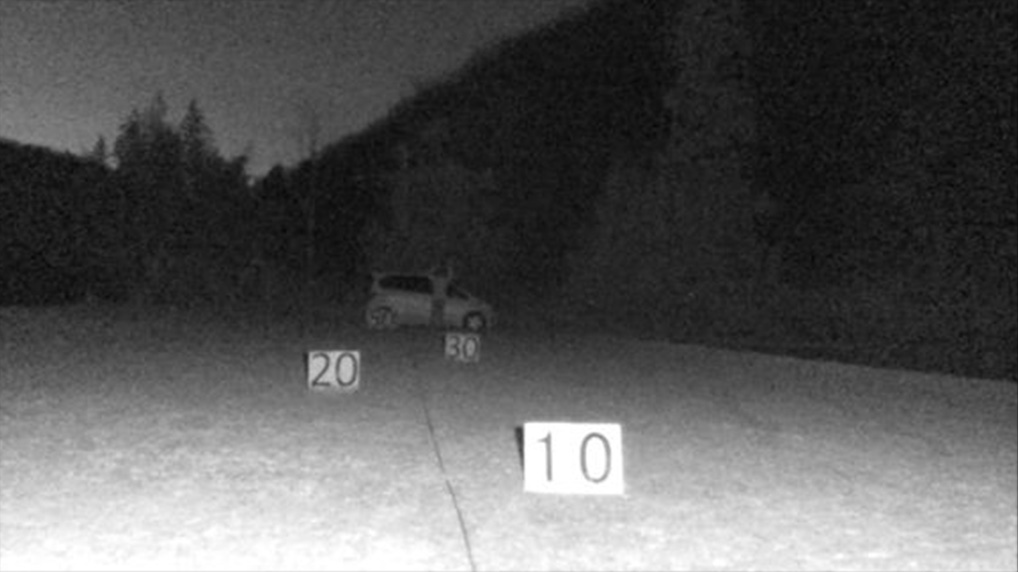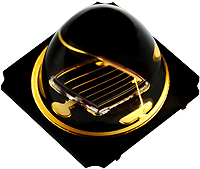Security World-class high luminous efficiency
IR LED
case study
TOA Corporation
TOA Corp. is using our high-power infrared LEDs in their TRIFORA Security Camera series. This time, we heard from Mr. Kunitake and Mr. Mashiko of the TOA Global Development Department concerning the use of Stanley Electric infrared LEDs and their effectiveness with regard to the advancement in security cameras.
 TOA
TOAGlobal Development Department
Solutions Development Division
Mr. Kunitake
 TOA
TOAGlobal Development Department
Solutions Development Division
Mr. Mashiko
Outdoor video cameras featuring high image quality, long recording time and high sensitivity
First, we would like you to introduce your security cameras equipped with infrared LEDs.
This is the 2nd generation TRIFORA series, a full revamp of the 1st generation launched in 2014. Launched in July 2018, this product is an outdoor video camera featuring high image quality, long recording time and high sensitivity, equipped with an electric zoom lens that can be adjusted over a network. Being able to record clear pictures with small storage size is extremely important for security cameras.
Furthermore, it is equipped with two types of light source ― long range illumination high-power infrared LEDs and close range illumination mid-power infrared LEDs ― that make sharp shots at both long range and close range possible.
Since outdoor cameras are often used in apartments and buildings entrances and service entrances, cameras that can see clearly in dark locations are our bestselling lineup. This time, high-power infrared LEDs were employed to shoot at a longer range.
Compared to other companies' products, our cameras enable the user to take clear pictures in low light (at night), with no screen flicker or blur. The entire series' counterlight compensation capability enables excellent correction of afternoon sunlight and car headlights at nighttime.
 Security camera using infrared LEDs
Security camera using infrared LEDsHigh performance was achieved thanks to a well-balanced configuration of long range and close range infrared LEDs
Regarding infrared LEDs, what were the difficulties you faced in changing from through-hole (shell) type LEDs to surface mount type LEDs?
Configuring the circuit was the most challenging task. So far, we have been using a circular shaped through-hole configuration, but this time we changed the concept; by using a well-balanced configuration of long range and close range infrared LEDs, we obtained a better performance using fewer LEDs compared to conventional products. The goal was illumination at 50m ― testing in an environment close to 0 lux ― but we could not achieve the desired performance.
At that time, when we conferred with Stanley Electric regarding circuit board configuration, they soon prepared several samples with different circuit board configurations. By testing those samples over and over, we found the best configuration.
Originally, while we were still using through-hole type LEDs it was suggested that we use surface mount types, but there were many concerns regarding heat and configuration, hence no one actually tried. However, thanks to proposals and support from Stanley Electric sales reps, when we actually evaluated surface mount LEDs, there were fewer problems than we had feared.
Would you give us some background on why you decided to change from through-hole type LEDs to surface mount LEDs?
Using infrared LEDs to see clearly at a long distance in dark locations has been our products' selling point since we started manufacturing analog cameras. Using those strengths, we started developing a camera that could see at a longer range than other companies, and aimed at increasing the irradiation range from 20m to 50m in order to respond to market requests for longer range.
To obtain an irradiation range of 50m using through-hole type LEDs it was necessary to use more LEDs with narrow spatial distribution, but issues arose, such as heat increase/decrease in the amount of light emitted by each LED, or light concentrated in the center resulting in unnatural pictures surrounded by darkness. For that reason, we thought that by using surface type LEDs emitting bright light at a wide range we might avoid image loss.
As a result, we have secured the highest standard of infrared illumination distance in fixed mount cameras for the Japanese market.
We received quick and cordial response to our technical questions (e.g. regarding LED configuration).
How did you find out about our products?
When we decided to use surface mount type LEDs, at first we used products from other companies to build prototypes.
Originally we have been using Stanley Electric's visible light LEDs as a light source for indicators, but we received information from other departments about a lineup of high-power infrared LEDs. Since we had some issues with the LEDs used for our prototypes, we conferred with Stanley Electric about them and looked for solutions together.
Can you tell us what the decisive factor in starting to use them was?
Basically, good customer support was a key factor. We considered overseas makers from a cost standpoint, but answers to our questions took time, and we did not manage to discuss the real problem — LED circuit configuration. However, Stanley Electric quickly answered our technical questions, and provided support in mounting the LEDs on our prototype circuit board. Since security cameras are permanently energized products, life cycle and reliability were also a major issue. Still, because we received immediate response to our questions, we felt secure in using them.
How did using them affect your products?
In contrast with conventional LEDs — where the center is bright, but the overall image is distorted — our evaluation of your wide-angle infrared LEDs revealed that they realized uniform radiation and uniform brightness. As for appearance, many customers commented that it looked better and more stylish than lining up a lot of through-hole type LEDs, and by greatly reducing the number of mounted LEDs we gained high approval from customers that dislike the red glow.
Moreover, our productivity improved. Using many through-hole type LEDs required complicated manual mounting due to height and angle placement. However, surface mount type LEDs made it possible to configure the circuit with no irregularities using a mounter, which speeded up production.
 conventional
conventional new models
new modelsResponse to the diversification of needs in security cameras
How about your innovation efforts in the security business?
Hardware differentiation in the industry is now difficult, so we think that AI and deep learning softwares will be the place for differentiation. Still, we think that by using parts like Stanley Electric's LEDs that have distinct advantages, we will have an edge over other companies with "hardware that supports software".
How will security cameras advance in the future? What are your expectations for LEDs?
First of all, it is good to be able to realize long range irradiation, but we believe that needs will continue to diversify in the future. While thinking about how to irradiate LEDs as far as 100m and 200m, we think that it is necessary to consider how to respond to the need to shoot with a wide-angle lens. In addition to monitoring the camera image, it is important to know how to sense information from the image and how to communicate it; that is why applications that can be used for both close range and long range will increase. Therefore, infrared LEDs also need variations in accordance with their needs — not just high power types.
Secondly, we think that in the future the image will not just be seen as it is. With progress in machine learning and image enhancement devices, the trend toward capturing a large wide range with cameras, and extracting from it only the necessary information will continue. To do that, we think it will be necessary to use LEDs that irradiate a wide area (instead of spot LEDs). For this reason, in the future the demand for infrared LEDs that can irradiate both near-range and wide-range will increase.

- TOA Corporation Company Profile

For video devices, sales started in 1983, and domestic sales are now centered on both coaxial cameras and IP cameras. They are developing diverse solutions to meet customer needs not only limited to security applications.

 MGN1105MS
MGN1105MS JGN1104LS
JGN1104LS